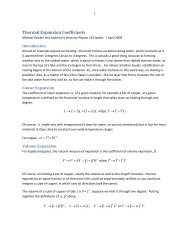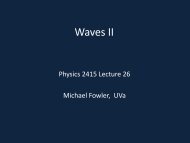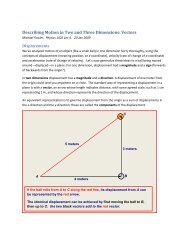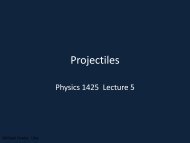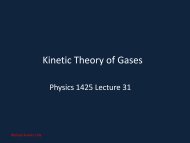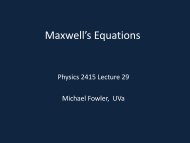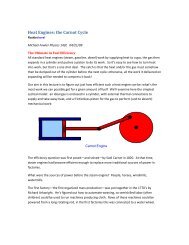The Pendulum - Galileo and Einstein
The Pendulum - Galileo and Einstein
The Pendulum - Galileo and Einstein
Create successful ePaper yourself
Turn your PDF publications into a flip-book with our unique Google optimized e-Paper software.
<strong>The</strong> <strong>Pendulum</strong><br />
Michael Fowler 3/24/09 (from Physics 152)<br />
<strong>The</strong> Simple <strong>Pendulum</strong><br />
<strong>Galileo</strong> was the first to record that the period of a swinging lamp high in a cathedral was independent of<br />
the amplitude of the oscillations, at least for the small amplitudes he could observe. In 1657, Huygens<br />
constructed the first pendulum clock, a vast improvement in timekeeping over all previous techniques.<br />
So the pendulum was the first oscillator of real technological importance.<br />
<br />
Simple pendulum: a mass m at<br />
the end of a rigid light rod of<br />
length l, constrained to rotate in a<br />
vertical plane.<br />
mg sin<br />
mg cos<br />
In fact, though, the pendulum is not quite a simple harmonic oscillator: the period does depend on the<br />
amplitude, but provided the angular amplitude is kept small, this is a small effect.<br />
<strong>The</strong> weight mg of the bob (the mass at the end of the light rod) can be written in terms of components<br />
parallel <strong>and</strong> perpendicular to the rod. <strong>The</strong> component parallel to the rod balances the tension in the<br />
rod. <strong>The</strong> component perpendicular to the rod accelerates the bob,<br />
2<br />
d <br />
ml mg sin .<br />
2<br />
dt<br />
<strong>The</strong> mass cancels between the two sides, pendulums of different masses having the same length behave<br />
identically. (In fact, this was one of the first tests that inertial mass <strong>and</strong> gravitational mass are indeed<br />
equal: pendulums made of different materials, but the same length, had the same period.)
2<br />
For small angles, the equation is close to that for a simple harmonic oscillator,<br />
d <br />
l<br />
dt<br />
2<br />
g<br />
,<br />
2<br />
with frequency g/<br />
l , that is, time of one oscillation T 2 l / g.<br />
At a displacement of ten<br />
degrees, the simple harmonic approximation overestimates the restoring force by around one part in a<br />
thous<strong>and</strong>, <strong>and</strong> for smaller angles this error goes essentially as the square of the angle. So a pendulum<br />
clock designed to keep time with small oscillations of the pendulum will gain four seconds an hour or so<br />
if the pendulum is made to swing with a maximum angular displacement of ten degrees.<br />
<strong>The</strong> potential energy of the pendulum relative to its rest position is just mgh, where h is the height<br />
difference, that is, mgl <br />
for small angles.<br />
1 cos . <strong>The</strong> total energy is therefore<br />
2 2<br />
1 d<br />
1 d<br />
1 2<br />
E <br />
2<br />
ml mgl 1 cos<br />
<br />
2<br />
ml <br />
2<br />
mgl<br />
dt dt <br />
<strong>Pendulum</strong>s of Arbitrary Shape<br />
<strong>The</strong> analysis of pendulum motion in terms of angular displacement works for any rigid body swinging<br />
back <strong>and</strong> forth about a horizontal axis under gravity. For example, consider a rigid rod.<br />
<strong>The</strong> kinetic energy is given by<br />
I where I is the moment of inertia of the body about the rod, the<br />
1 2<br />
2<br />
,<br />
potential energy is mgl 1<br />
cos<br />
<br />
distance of the center of mass from the axis.<br />
as before, but l is now the<br />
<strong>The</strong> equation of motion is that the rate of change of angular<br />
momentum equals the applied torque,<br />
I mgl sin<br />
,<br />
for small angles the period T 2 I / mgl , <strong>and</strong> for the<br />
simple pendulum we considered first<br />
previous result.<br />
I ml 2 , giving the<br />
Variation of Period of a <strong>Pendulum</strong> with Amplitude<br />
As the amplitude of pendulum motion increases, the period lengthens, because the restoring force<br />
3<br />
mg sin<br />
increases more slowly than mg ( sin / 3! for small angles).
position in radians<br />
position in radians<br />
3<br />
<strong>The</strong> simplest way to get some idea how this happens is to explore it with the accompanying<br />
spreadsheet.<br />
Begin with an initial displacement of 0.1 radians (5.7 degrees):<br />
0.15<br />
Simple <strong>Pendulum</strong><br />
0.1<br />
0.05<br />
0<br />
-0.05<br />
0 0.5 1 1.5 2 2.5 3 3.5 4 4.5<br />
-0.1<br />
-0.15<br />
time in seconds<br />
Next, try one radian:<br />
1.5<br />
Simple <strong>Pendulum</strong><br />
1<br />
0.5<br />
0<br />
-0.5<br />
0 0.5 1 1.5 2 2.5 3 3.5 4 4.5<br />
-1<br />
-1.5<br />
time in seconds<br />
<strong>The</strong> change in period is a little less that 10%, not too dramatic considering the large amplitude of this<br />
swing. Two radians gives an increase around 35%, <strong>and</strong> three radians amplitude increases the period<br />
almost threefold. It’s well worth exploring further with the spreadsheet!





